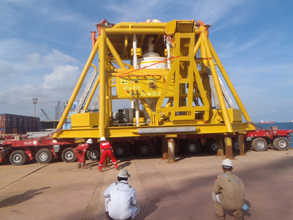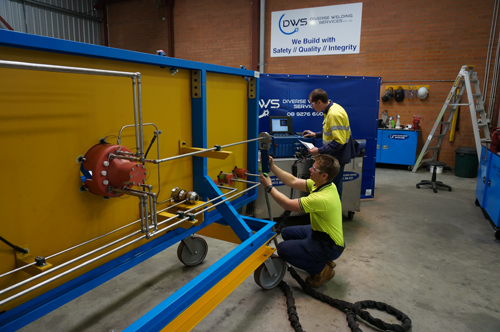
Stainless steel is the material of choice for subsea hydraulic and control line applications because of its excellent corrosion resistance, material strength benefits and weldability.
Subsea production in the oil and gas industry involves offshore, in situ equipment to facilitate the exploration, development, production and transportation of energy reserves from underwater fields. It is a viable form of oil and gas production, providing economic, productivity and environmental benefits.
Perth-based ASSDA Member and Accredited Fabricator Diverse Welding Services (DWS) recently completed detailed design and fabrication works on two major subsea projects operated by multinational oil and gas exploration and production companies.
Apache Corporation’s Coniston and Novara Redevelopment Project, completed in February 2014, is a subsea oil field located 65km north of Exmouth. The project involved an upgrade to the Ningaloo Vision floating production, storage and offloading (FPSO) unit and development of the neighbouring Coniston and Novara oil fields, which links these fields into the existing Van Gogh manifolds via dual production flow lines. The equipment operates in water 340 to 400m deep.
DWS was contracted to detail the design, fabrication, installation and NDT testing of the small-bore hydraulic control and chemical injection lines for five subsea production manifolds.
2,380m of 316L stainless steel wall tube in various sizes ranging from 0.375” OD x 0.083” up to 1.000” OD x 0.156” was used, plus 30m of Inconel 625 0.750” OD x 0.134” wall tube.
Chevron Australia’s Wheatstone Project, located 12km west of Onslow on the Pilbara coast of Western Australia, is one of Australia’s most significant LNG projects. Currently in progress and at almost 60% complete, it will become the country’s first third party natural gas hub. DWS was contracted to fabricate, install and test small-bore tubing and free issue components to Multiple Quick Connect (MQC) plates. The main free issue components consisted of logic caps, cobra heads, single line couplers and acid injection items requiring small-bore interconnecting tubing on four MQC plates serving the subsea isolation valves (SSIV) for the 44” trunkline, 24” and 14” flowlines, and the 18” APACHE/KUFPEC line.
SAF2507 super duplex stainless steel was used for the MQC plates including over 80m of 0.625” OD x 0.083” wall tube, 20m of 316L 0.375” OD x 0.083” wall tube and 130 Swagelok 90° elbow butt-weld fittings. The MQC plates were fabricated by PT Profab Indonesia, then shipped to DWS in Perth for detailed fit-out using autogenous orbital welding processes. After testing, the completed MQC plates were shipped back to PT Profab Indonesia for installation into the SSIV manifolds.
All welding by DWS for both projects was completed using an autogenous orbital welding process, specified by the clients for the small-bore hydraulic tubing welding due to its excellent control of welding variables, repeatability of application and maximisation of corrosion resistance of exotic materials. DWS produced high quality welds that when tested under the G48 Method A – Pitting Resistance Testing, proved resulting weight loss to be less than 0.36g/m2.
Orbital welding is an automatic method of Tungsten Inert Gas (TIG) welding of thin tubes, usually without filler wire. Its advantages are a uniform weld profile and excellent gas shielding giving minimal heat tint. The ends of the tube are prepared and clamped in an enclosed head, which is flushed with external shielding and internal purging gas – usually argon, although gas mixtures can be used. The cycle starts by striking the arc and proceeds as the head slowly rotates around the tube. A specific weld head can deal with several diameter tubes. The weld is usually in the centre of the head, although heads are available for offset joins used with joints to elbows or valves.
DWS completed 1200 welds for the Coniston and Novara Redevelopment Project and 204 welds for the Wheatstone Project, which passed 100% radiographic/liquid penetrant testing in accordance with ASME B31.3 NFS. The excellent gas and heat input control of the orbital welding produced internal surfaces that did not require post-weld cleaning. The external surfaces around the welds were abrasively treated as required for aesthetics reasons.
The DWS facility includes five autogenous welding machines complimented with seven welding heads of assorted ranges allowing DWS to complete weldments from 0.25” OD to 6” OD tube/pipe schedules as required for these project works. This coupled with their extensive range of other qualified weld procedures for this process allows DWS to meet clients’ stringent fabrication, application and quality specifications.


This article is featured in Australian Stainless Issue 55 (Winter 2015).